Adam Yamey's Blog: YAMEY, page 143
November 27, 2021
Piling it on along the canal
NEEDING BREAKFAST ON our way from Warwick to visit Baddesley Clinton House, we chose to stop at the Hatton Locks Café, which we had noticed on our road map. What we did not know is that the café is located next to the uppermost of a flight (or series) of 21 canal locks. The locks are situated on a stretch of the Grand Union Canal that was, when it opened in 1799, the Warwick and Birmingham Canal, which was built to carry locally mined coal for use in power stations and nearby factories (https://canalrivertrust.org.uk/enjoy-the-waterways/canal-history/history-features-and-articles/the-history-of-hatton-locks). It became an important transportation link between London and The Midlands.

The 21 locks are spread along an almost 2 mile stretch of the canal and the towpath along this section of the waterway is popular with cyclists, walkers, and their dogs. Some of the locks are narrow. They were built when the canal was first constructed. Other locks on the flight are far wider. They were built in 1932 and allow two craft to use the lock simultaneously. The newer locks were built at a time when the canal system began to have to compete with motorised road and rail transport.
The café is about 310 yards northwest of a small car park and is reached by walking along the towpath. Near the café, there are some unusual looking tables and benches made of old timber. Most of the timber pieces are planks with a short semi-circular projection at one end. These wooden piles used to be driven into the floor of the canal between parallel wooden blocks that held them straight upright against the walls of the waterway. Their purpose was to prevent the banks of the canal from being eroded by the water flowing past them. Nowadays, they have been replaced by coir matting that serves the same purpose because it is considered to be more eco-friendly that timber. The wooden piles were driven into place by a mechanised hammer system aboard a motorised boat that plied along the canal. One of these boats, now disused, has been preserved near the café.
The locks on the Hatton Flight looked different from the many other canal locks we have seen on our travels around the country. Each lock is flanked by what looks like a pair of tall, stout candles. These things house the mechanisms that control the flow of water into the locks and are operated by canal users equipped with a special handle or windlass that fits onto a projection that is linked to the gearing that operates the valve.
The Hatton Locks Café is a real treat, both visually and gastronomically. Both inside and outside, it is decorated with a profusion of objects, some folkloric, some whimsical, and others related to the life and traditions on the canal. A team of friendly workers produce simple but excellently prepared English breakfast items as well as very acceptable coffees. So good was our breakfast that we made a detour to return to this place on the following morning. Most of the clientele seemed to be locals, many of whom were on friendly terms with the staff. Although we had only been once before on a busy morning, the staff remembered exactly what we ate and drank on the day before. When we are next nearby, we shall certainly visit this wonderful establishment again. On our next visit, we will join the other walkers and stroll past all the 21 locks.
November 26, 2021
Look no hands!
SPENCER STREET in Royal Leamington Spa has a building with an intriguing façade. It is not so much the brick and stonework on the building that attracted my attention but a stone statue of a woman with a gold-coloured sphere on her head. She is perched above the centre of the façade of the edifice that bears the words “The Bath Assembly Hall” and the date when it was built: 1926.
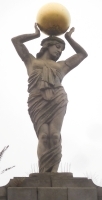
Designed by Horace G Bradley (1877-1961), it was originally a dance hall with shop premises. It was typical of the type of dance hall that:
“…flourished in the inter-war period of the C20 and survived through to the 1950s and early 1960s. Cultural changes have meant that the great majority have been demolished or considerably altered when adapted for other purposes. This example, with its boisterous classical decoration, expressed inside and out, survives in a highly intact state. Its façade mirrors the decorative style of the interior which has an integrated and fluid plan.” (https://historicengland.org.uk/listing/the-list/list-entry/1391731).
Sadly, I did not have enough time to try to enter it.
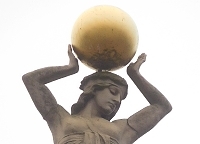 Look, no hands!
Look, no hands!The statue on top of the building represents Terpsichore, one of the nine Greek Muses. She was the patron of lyric poetry and dancing, so her image was appropriately chosen to adorn a dance hall. Something that interested me about the statue became obvious when I used the zoom on my camera. I noticed that although her hands are close to the sphere on her head, they do not touch it. The gold ball seems to be attached to her head by a single rod. The scantily dressed Muse is depicted looking down on the street far below. Maybe, she is thinking “I can balance the ball on my head, look, no hands.”
November 25, 2021
Leamington Spa, Heydrich, and the tragedy at Lidice
CLOSE TO WARWICK, there is a town that reminded me both of Brighton on the south coast of England and Mariánské Lázně (Marienbad) in the Czech Republic. The grandiose architecture, mostly neo-classical, of Leamington Spa reminds me of some parts of Brighton and the area around the town’s spa buildings, both new and old, brought faint recollections of visits I made long ago to the Czech spa town to my mind. What I did not know when we visited Leamington Spa was that it does have a not too distant historical relationship with what was once known as ‘Czechoslovakia’.
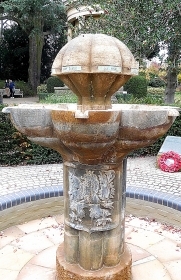 Czechoslovak memorial in Leamington Spa
Czechoslovak memorial in Leamington SpaSS General Reinhard Heydrich (1904-1942) was one of the main ‘architects’ of the Holocaust and in 1942 he was the acting Governor of the Protectorate of Bohemia and Moravia, the area now known as the Czech Republic. In January 1942, he was Chairman of the Wannsee Conference at which the terrible fate of the Jewish people was decided. On the 27th of May 1942, Heydrich was shot at while driving through Prague. During this attack, a hand grenade, thrown into his open top vehicle, exploded. Heydrich was rushed to hospital but died of his wounds or sepsis resulting from them early in the morning of the 4th of June. His senior, the Chancellor of Germany, the dictator Adolf Hitler, was furious.
The assassination attack was carried out by Czechoslovak men who had been trained in England and then parachuted into Czechoslovakia. The men were volunteers, who were members of the Free Czechoslovak Forces stationed in the Warwickshire town of Royal Leamington Spa, where there was a training camp for them. It had been there since 1940. Seven of the Czechoslovak men flew from England in December 1941 and parachuted at various paces over their native land. Two of them, Jozef Gabčík (1912-1942) and Jan Kubiš (1913-1942), carried out the attack in Prague that led to the ending of Heydrich’s life. These two men and the others dropped over Czechoslovakia sacrificed their lives in the struggle to free their country from Nazi tyranny.
In November 2021, we paid a brief visit to Leamington Spa. Amongst its attractions is the pleasant Jephson Gardens, which are close to the spa establishments after which the town gets its name. The Park is named after the physician and philanthropist Henry Jephson (1798-1878), who promoted the superior healing powers of the town’s spring water. An attractive circular neo-classical temple containing a statue of Jephson was erected in his honour in 1849. This stands atop a small mound. Close to it there is another monument, also circular.
The other monument was unveiled in 1968, 50 years after the formation of Czechoslovakia out of the ruins of the failed Austro-Hungarian Empire. The memorial is in the form of a circular fountain. A bowl is supported by a single pillar on which the heraldic emblem of Czechoslovakia can be seen in bas-relief. Something, which at first sight resembles a large mushroom, sprouts upwards from the centre of the bowl. Closer examination of this reveals that it is a sculpture depicting a cluster of open parachutes. On each parachute, there is a name of one of the group of volunteers who parachuted into Czechoslovakia. The monument was designed by John French.
According to a noticeboard close to the Czechoslovak volunteers’ memorial, this small fountain also remembers the thousands of Czechoslovak citizens, who were murdered by the Nazis in reprisal for Heydrich’s death. After numerous arrests were made, two Czech villages suspected of having been involved in the assassination plot, Lidice and Ležáky were literally wiped off the face of the earth by the Nazis. Their innocent inhabitants were mostly killed, but some were sent to concentration camps. These poor people are remembered in Jephson Park, which is such a lovely place that one would not think that it could possibly be even remotely associated with the human tragedies that followed the death of a monstrous member of the Nazi party.
November 24, 2021
Buckingham, but not the Palace
A LARGE GOLDEN SWAN with wings outstretched towers over the small town of Buckingham, once the county town of Buckinghamshire (until the 18th century, when Aylesbury took over this role) and now home to a respected private university, with whose founding my late father was to some extent involved. The gold-coloured copper swan surmounts a clock above the roof of an elegant late 18th century building on Market Square. Built in about 1783, this is The Old Town Hall, but not the oldest that the town has known.

The Old Town Hall was built to replace an even older one constructed in 1685 at the instigation of a local Member of Parliament, Sir Ralph Verney (1613-1696), during whose life the Civil War occurred. Initially on the side of the Parliamentarians, he fell out with them and fled abroad for a few years. After King Charles II gained the Throne, Verney returned to England where he served his people and the monarch.
In 1882, the clock was added above the Old Town Hall and upon this was placed the Swan of Buckingham, the borough’s crest. The wrought iron canopy over the main entrance was added early in the 20th century. The façade of the Old Town Hall faces another building, a well-known landmark and tourist attraction in the town, The Old Gaol, built in 1748 with its façade added in 1839.
The Old Town Hall was used for municipal administration until the 1960s when the local government headquarters were established elsewhere in the town. Now, the building is home to a firm of solicitors and the large metal swan high above their offices provides a nice perch for groups of the town’s pigeons.
November 23, 2021
Costly coffee, Handel, and Hendrix in London’s Mayfair
THERE ARE TWO entrances to Lancashire Court from Mayfair’s Brook Street. One of them, the closest to New Bond Street, is a cobbled lane leading down to a courtyard occupied by the back entrance of the Victoria’s Secret store and the outdoor tables of a restaurant called Hush Mayfair. The tables under delightfully decorated canopies looked enticing, and as we felt the need for some coffee, we sat down to enjoy small macchiatos (maybe more correctly, ‘macchiati’). The coffees were enjoyable but not exceptional. However, the bill that arrived after we had drunk our tiny coffees was far from unexceptional. We were charged just under £13 (US $17.46, INR 1300, or EUROS 15.25) for our two hot drinks. Just in case you are not familiar with the London café scene, today, November 2021, two macchiatos usually cost between £4 and £6.
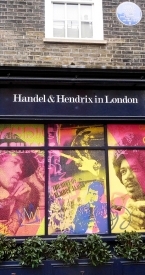
Lancashire Court is a network of lanes and courtyards located behind the buildings on the southwest corner of the intersection of New Bond Street and Brook Street. It was once a part of London, the Conduit Mead Estate (www.ianvisits.co.uk/blog/2021/07/05/londons-alleys-lancashire-court-w1/, an informative web page), that followed the course of an old water conduit that ran through the area in a north/south direction (for a map of the district, see: www.bl.uk/onlinegallery/onlineex/crace/t/largeimage88092.html). From the 1730s until the 1970s, the buildings in Lancashire Court included many workshops, warehouses, and builder’s yards. In 1987, there was a plan to demolish the network of alleys and replace it with a new shopping complex, but this never materialised. Now, the old businesses have been replaced by ‘chic’ establishments including the place where we enjoyed our exorbitantly priced coffees.
Returning to Brook Street, the short section lying between the two entrances to Lancashire Court has two neighbouring houses, numbers 23 and 25, which have importance in the history of music in London. The composer of well-known works such as “The Messiah” and “The Water Music”, George Frideric Handel (1685-1759), moved into what is now number 23 in the summer of 1723, and lived there until his death (https://handelhendrix.org/plan-your-visit/whats-here/handel-house/). In Handel’s time, Brook Street was known as ‘Lower Brook Street’. Handel’s home included a Music Room in which as many as 40 people would be accommodated to perform and listen to Handel’s latest creations.
In 1968, 209 years after Handel died, another musician moved into number 25, the house next door to number 23 Brook Street. Like Handel, the occupant of number 25 was a musical innovator. His name was Jimi Hendrix (1942-1970). According to a useful website (https://handelhendrix.org/plan-your-visit/whats-here/hendrix-flat/):
“The flat on the upper floors of 23 Brook Street was found by Jimi’s girlfriend Kathy Etchingham from an advert in one of the London evening newspapers in June 1968 while he was in New York. He moved in briefly in July before returning to the United States for an extensive tour. He spent some time decorating the flat to his own taste, including purchasing curtains and cushions from the nearby John Lewis department store, as well as ornaments and knickknacks from Portobello Road market and elsewhere. He told Kathy that this was ‘my first real home of my own’.
He returned to Brook Street in January 1969 and almost immediately launched into an exhaustive series of press and media interviews and photo shoots in the flat. On 4 January he made his infamous appearance on the BBC Happening for Lulu TV show, and gave his two Royal Albert Hall concerts in February. In March he was back in New York again and although Kathy remained at Brook Street for a while longer Jimi did not live there again.”
After Hendrix’s girlfriend left the flat, it was used as office space. In 2000, it was taken over by the Handel House Trust. By 2016, both Handel’s House and Hendrix’s flat became open to the public as a museum, which I have yet to visit. Sadly, since the onset of the covid19, the museum, now known as ‘Handel and Hendrix in London’ is only open occasionally and will open fully in March 2023.
The westernmost of the two Brook Street entrances to Lancashire Court is lined with an attractive mural made from ceramic tiles. Created in 2001 by Michael Czerwiǹski (with Ray Howell), it celebrates Handel’s residence in Brook Street. Amongst the many works he composed whilst living there, here is a very small selection of them: the opera “Rodelinda”; “The Messiah” and “Semele”; and “Music for the Royal Fireworks”.
Each of the two musicians of Brook Street did much to change the course of musical history. I wonder what each would have thought of the other, and which of them has the most listeners today. Whatever the answers, their names will live on in people’s minds far longer than that of both the place where we had costly coffee and the currently trendy Victoria Secret high-end but low-cut lingerie store.
November 22, 2021
Fallen leaves amongst the fallen: Field of Remembrance
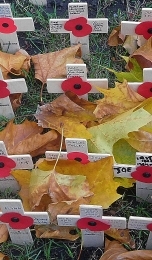
I HAVE LIVED in London for well over 60 years, but it was only this November (2021) that I first became aware of, and experienced, something that has been happening annually on the north side of Westminster Abbey since November 1928 (www.poppyfactory.org/about-us/history...#). For eight days following the Thursday preceding Remembrance Sunday, the Sunday closest to Armistice Day, the 11th of November, the day on which WW1 ended, the field bounded by Westminster Abbey and its neighbour, the church of St Margaret’s Westminster, is covered with a myriad of mostly tiny wooden memorials hammered into the grass. The memorials are mostly cross-shaped, but some are in the form of crescents, six-pointed stars, and other shapes including some that bear the Sanskrit symbol representing ‘aum’ (or ‘om’). Each of these tiny wooden items commemorates a fallen service person or other victim of war. The shapes of the wooden pieces denote the religion of the person or persons being remembered, be they Christian, Hindu, Sikh, Moslem, Jewish, or of no religion. Many of the wooden memorials have red poppies attached. Oddly, few if any of the Islamic crescents had poppies on them. The small wooden memorials are arranged in groups, according to which service or regiment or organisation the remembered people were members of, or associated with. The whole ‘event’ is organised by The British Legion Poppy Factory. This annual garden of memorials is called The Field of Remembrance.
The Poppy Factory, a charity, was founded in 1922 by Major George Howson (1886-1936) to provide employment for veterans injured during WW1. He bought a site in Richmond (south-west London), where he established a factory to manufacture Remembrance poppies and other related items to be sold to raise money for The British Legion’s Red Poppy Appeal, a charity that supports the Armed Forces community.
Apart from the small wooden memorials, there are many badges and emblems of the groups in which those remembered were members. Looking at these and the small wooden memorials is both fascinating and extremely moving. The fascination lies in the huge variety of regiments and organisations, too many to list, which lost people during military conflicts (and terrorist incidents) since the onset of WW1.
One group of memorials interested me because of their emblem that incorporates a heraldic creature, which has fascinated me for several decades. The creature is the double-headed eagle (‘DHE’), currently used as an emblem by countries including Albania, Serbia, Montenegro, the Indian state of Karnataka, and Russia. The DHE appears on the crests of some of the various regiments of The Royal Dragoon Guards. The Dragoon Guard regiments were first established in the 18th century, in 1746, and consist of mounted infantry. While the Austro-Hungarian Empire existed, it also used the DHE. In 1896, Emperor Franz Joseph I of Austria (1830-1916) of Austria-Hungary was appointed Commander-in-Chief of the 1st King’s Dragoon Guards, some of whose members are remembered in the Field of Remembrance. The emperor allowed the regiment to wear his empire’s emblem (https://web.archive.org/web/20130303033912/http://www.qdg.org.uk/pages/Uniform-1843-Onwards-81.php), the DHE. In addition, the regiment adopted “The Radetzky March” as one of its official march tunes; it is still used today. It was sad that in 1914, Franz Joseph, became the ruler of one of the powers against whom Britain and its allies were fighting. Some of those who fought in the British Royal Dragoon Guard regiments with the DHE on their headwear were killed by allies of the emperor in WW1, who had earlier been appointed their C-in-C. They are commemorated the Field of Remembrance. Judging by the small wooden memorials planted in the Royal Dragoon Guard’s section of the Field of Remembrance, members of at least four religions fell while serving in these regiments. I wondered why the DHE was retained even after Austria-Hungary became one of Britain’s opponents in war.
Returning to the Field of Remembrance as a whole, it is a poignant sight to behold. Although war is both horrific and ugly, this annual memorial is both moving and beautiful. The Field is laid out beneath trees lining its northern edge. Seeing the dead leaves from these trees lying fallen amongst the thousands of tiny memorials to victims of war seemed most apt to me.
November 21, 2021
The weathervane
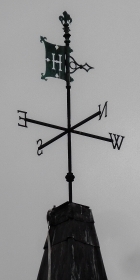 Weathervane in London’s Holland Park
Weathervane in London’s Holland ParkWhether the wind blows
North or south or east or west
I will show you which
November 20, 2021
Pianos and art deco in Mayfair
THE CORNER OF BROOK Street and Haunch of Venison Yard (in London’s Mayfair) is adorned with a fine building with a white Portland stone façade. It is built in the art deco style. The building, Greybrook House (28 Brook Street), was constructed in 1929 and designed by Sir John Burnet and Partners (https://historicengland.org.uk/listing/the-list/list-entry/1392996). Burnet, born in Scotland, lived from 1857 to 1938.
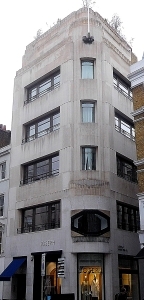
Greybrook House was built to house the showrooms of the piano company, Bechstein, founded in 1853 by Friedrich Wilhelm Carl Bechstein (1826-1900). In 1901, the firm opened a concert hall, Bechstein Hall, on Wigmore Street. In 1917, the hall was renamed the Wigmore Hall and is still used today. The hall was next to Bechstein’s showrooms, which were closed in 1916 because of its German connection. In 1928, Bechstein’s, which had been closed during and after WW1, re-established itself in the UK, and commissioned the building of Greybrook House to be used for their new showrooms. In addition to showrooms, the new building included practice rooms and office space.
I am not sure when Bechstein left its Brook Street premises. However, I noticed that beside the entrance to the flats there is a beautifully carved calligraphic inscription that reads “Allied Ironfounders Ltd”. This company had its showroom in Greybrook House in the 1950s. Judging by a photograph I have seen on the Internet (www.ribapix.com/allied-ironfounders-s...#), it must have been quite exciting visually.
Currently, the ground floor of Greybrook House is occupied by Joseph, an upmarket clothing retailer. The upper floors have been converted into luxury flats by Fenton Whelan and Vanbrugh Prime Property. This was done recently.
The lovely art deco façade of Greybrook House remains unaltered. By chance, or who knows, maybe deliberately, Bechstein’s Brook Street showrooms were almost opposite the house where the composer George Frideric Handel (1685-1759) lived from 1723 until his death. Finally, the company that had its piano showrooms in Greybrook House is currently constructing a new set of showrooms and a small 100 seat concert hall back in Wigmore Street where their first London premises were located (www.rhinegold.co.uk/international_pia...).
November 19, 2021
They had no choice
ARMISTICE DAY IS celebrated annually on the 11th of November, the day that fighting came to an end in WW1. The day is to celebrate and:
“…remember all those who gave their lives in service to their country since 1914.” (https://www.britishlegion.org.uk/get-involved/remembrance/about-remembrance/armistice-day). It was not only humans who sacrificed their lives, either willingly or less willingly, but also animals, who had been employed in warfare. A monument on a wide traffic island in London’s Park Lane was constructed to remember these four-legged creatures who lost their lives prematurely during battles from which they were unlikely to gain any benefit.
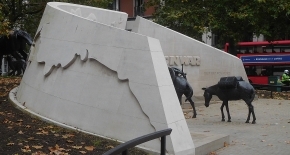
Erected by The Animals in War Memorial Fund (www.animalsinwar.org.uk/) and unveiled in 2004, this dramatic monument consists of a semi-circular Portland stone wall with a gap near its centre. Two bronze horses laden with military equipment are depicted walking towards the gap. and beyond the gap, a bronze sculpture of a running dog can be seen. The western part of the concave side of the wall has bas-reliefs depicting, horses, elephants, and camels. The eastern side of the concavity bears several inscriptions including one with the words “They had no choice”. The convex surface of the wall bears stylised silhouettes of horses. The monument was designed by David Backhouse and was inspired by the book “Animals in War” by Jilly Cooper.
“They had no choice” is a poignantly appropriate sentence on a memorial to creatures who were taken into fields of battle innocent of their likely fate. Seeing this moving monument made me think that these same four words could easily be applied to the numerous Indian participants in WW1 and WW2 who were sent to Europe as ‘volunteers’ innocent of their horrendous destination by their rulers in the Princely States of India, who wished to please the British, whom they served. Had these unfortunate servicemen known what they were about to face, some of them might have objected. That option was not one that would ever been open to the slaughtered animals commemorated on Park Lane.
November 18, 2021
Oscar Wilde, a bishop, and an art dealer
DOVER STREET RUNS north from Piccadilly, not far from The Royal Academy. It is a thoroughfare we often visit because it contains several commercial art galleries that frequently put on interesting exhibitions. One of these is the London gallery of Thaddeus Ropac. Not only does this international art dealer have good exhibitions, but the house in which the works of art are displayed, 37 Dover Street, is an artwork itsef, an architectural treasure.
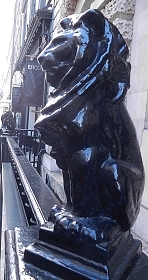
The architectural historian, Nikolaus Pevsner (1908-1983), whose writing I enjoy greatly, is a little dismissive of the buildings in Dover Street with one exception. In his “London Volume 1”, which was co-authored by Bridget Cherry, he wrote of this street:
“The only house which needs special attention is Ely House (No. 37)”
This is the building that is now home to Thaddeus Ropac. Ely House was built in the 1770s by the then Bishop of Ely, Edmund Keene (1714-1781), who was appointed to that post in January 1771. According to The Dictionary of National Biography (1885-1900 edition), Keene:
“… obtained in 1772 an act of parliament for alienating from the see, in consideration of the payment of 6,500l. [i.e., £6,500] and an annuity of 200l., the ancient palace in Holborn, and for purchasing, at a cost of 5,800l., the freehold of a house in Dover Street, Piccadilly, London. The present house on that site was built by him about 1776.”
Clearly, the bishop was not short of cash; he was married to Mary (née Andrews), daughter and sole heiress of Andrews of Edmonton, once a successful linen draper in Cheapside.
The architect of Ely House was Sir Robert Taylor (1714-1788). The building remained the London residence of the Bishops of Ely until the beginning of the 20th century. In 1909, the interior of Ely House was greatly modified by the Arts & Crafts architectural firm Smith and Brewer (https://ropac.net/news/245-galerie-thaddaeus-ropac-ely-house-london/), and it became the home of The Albermarle Club. This private members’ club, founded in 1874, was open to both men and women, and was first housed at 13 Albermarle Street. Known for its liberal views on women’s rights, it was in 1895 the site of an incident that led to the first trial of one of its members, the writer Oscar Wilde (www.back2stonewall.com/2021/02/gay-lg...). Because of the club’s connection with proceedings that led to Wilde’s downfall, it moved to 37 Dover Street to distance itself from Albermarle Street where these unfortunate events had occurred.
During WW2, Ely House became used by The American Red Cross Interstate Club. Later, it housed a private bank. When Pevsner and Cherry published their book in 1973, the house was being used by Oxford University Press. In Spring 2017, Thaddeus Ropac announced that they would open their London gallery in Ely House.
The exterior of Ely House might not have changed much since it was constructed. A medallion on the façade depicts a bishop’s mitre. The magnificent wrought iron railings topped with several models of lions was a 19th century addition based on the lions designed for The British Museum by the sculptor Alfred Stevens (1817-1875). The interior of Ely House would now be unrecognisable to Bishop Edmund Keene apart from a few decorative features that have been preserved. Furthermore, the artworks that are so beautifully displayed in the lovely, whitewashed rooms of the former Ely House would have seemed totally alien to the long-since departed bishop. Rarely, if ever, do the artworks displayed superbly in the gallery lack in visual interest and originality. What drew us to the gallery on the 9th of November 2021 was a small, intriguing collection of creations by Marcel Duchamp (1887-1968) in one room, and several rooms containing disturbingly lifelike, but not always life-sized, sculptures by Ron Mueck, an artist born in Australia in 1958, son of German-born toymakers.
Dover Street is part of a network of Mayfair thoroughfares containing commercial art galleries. Amongst them Thaddeus Ropac has the most beautiful premises and is worth seeing not only for its artworks but also as a fine example of London’s architectural heritage.



